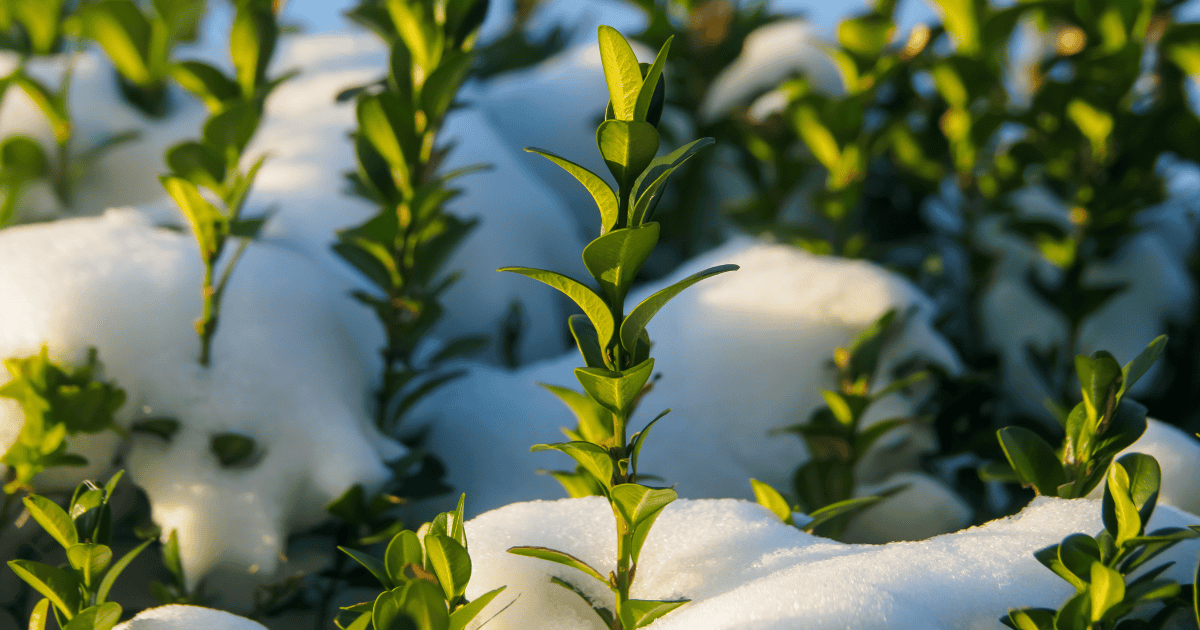
Avoid bronzing and other winter damage through proper plant placement and preventative care.
Boxwoods are prized for their evergreen foliage and cold hardiness, but when not cared for properly, these hard-working shrubs can become susceptible to winter damage. Dry winter winds and fluctuating temperatures take their toll on broadleaf evergreen plants like boxwoods, discoloring that gorgeous foliage and causing die back in extreme cases. Careful placement in the landscape and attention to plant health during the growing season promote greater resiliency against winter damage. Prevention is key to keeping your Better Boxwood shrubs looking their best through winter and beyond.

Winter Damage in Boxwood Shrubs
Deciduous plants drop their foliage in autumn, avoiding the stress that winter weather brings. Evergreen plants like boxwood retain their leaves year-round, which provides the benefit of continued photosynthesis throughout winter. However, this comes with the risk of desiccation.
During the winter months, evergreen plants use water reserves for photosynthesis and lose moisture through the foliage to evaporation and transpiration. Windy weather and warm spells can lead to significant water loss. When this occurs while the ground is frozen or soil is overly dry, plants are unable to take up enough moisture to replace what is lost. Water stress damages the foliage, resulting in damage commonly called winter burn or bronzing. Burned foliage may appear reddish-brown, yellow, or gray in color, or may completely lose color.
Even the most cold-hardy boxwood plants can be damaged by extreme weather. Bark splitting is the most severe type of cold damage and is caused by water freezing inside plant tissues. This typically occurs during extreme cold events or when freezing temperatures follow warm weather. Bark splitting may not be noticeable right away. Overtime, you may see entire branches dieback, especially in the middle and apical parts of the crown. If you look closely, you can see cracks on the stem where the bark has lifted away. In comparison, winter burn tends to affect only the tips of branches.

Avoid Winter Damage through Site Selection
Most winter damage of boxwood shrubs can be avoided through careful selection of the planting site and by preparing plants as they enter winter. Boxwoods planted in sites exposed to winter winds and sunshine tend to experience more damage than those grown in more protected or shady locations.
When planting new boxwood shrubs in the landscape, look for planting locations protected from prevailing winter winds, which tend to come from the northwest. Planting on the east sides of windbreaks such as fences, buildings, and large shrubs helps to block these drying winds. Existing shrubs planted in exposed sites can be protected in winter using snow fencing or a windbreak constructed from burlap or lattice.
Sun exposure also affects winter damage. Plants in sunny locations tend to lose water at a higher rate than plants receiving some shade. They also experience greater temperature fluctuations which can exacerbate the impacts of freezing temperatures. Boxwoods perform best in areas with partial shade to dappled sunlight. An eastern exposure providing morning sun is ideal. These conditions also benefit boxwoods in summer, protecting them from the hot afternoon sun.

Prevent Winter Damage with Proper Plant Care
Boxwoods are most susceptible to winter injury when plant health is compromised entering the winter. Make sure the plants enter the dormant season in a healthy and vigorous condition with adequate soil moisture. Mulch plants with a three-inch layer of wood chips or pine straw to help retain soil moisture and insulate the shallow root system against rapid temperature changes at the soil surface.
When the temperatures cool in autumn, it is easy to neglect watering the garden, but evergreen plants grow actively well into fall and all plants develop roots as long as soil temperatures remain above 40˚F. This means boxwood plants are using water through much of the year and still require regular irrigation, especially when rainfall is inadequate. Monitor rainfall and check soil moisture regularly through autumn, watering as needed.
Boxwoods plants use less and less water as the temperatures drop. Winter watering varies by location. In milder climates, provide supplemental irrigation one to two times per month as needed to maintain moist, but not damp, growing conditions. Moist soil helps insulate plant roots against extreme cold. When severe weather is predicted, thoroughly water newly planted boxwoods and those susceptible to winter damage before the ground freezes.
In cold climates, continue to water boxwood as needed until the ground freezes. Take advantage of warm spells during the winter to check soil moisture and irrigate if the soil has dried. Water only when air temperatures are above 40˚F, applying water mid-day to allow time for the water to soak into soils before potential nighttime freezes. Do not water over the top of snow cover.
Avoid Late-Season Pruning and Fertilization
Some management practices help to prevent winter damage, while others can make plants more susceptible. It is important to fertilize plants at the proper time of year. Make all applications before July, as applications late in the year encourages new growth that does not have time to harden off before the winter. The same is true of pruning. Heavy pruning late in the season can cause excess growth of tissues that will enter the winter in a tender condition. While fertilizing and pruning are important components of plant care, proper timing is critical.

Managing Snow and Ice
Snow is a great insulator, blanketing the soil below much like mulch. However, boxwoods can be damaged by heavy snow loads or ice storms. If plants are positioned beneath roof ledges or other areas where heavy deposits of snow are expected, it can be helpful to wrap large boxwoods, especially tall, upright varieties. In areas where ice storms are common, wrapping boxwood plants protects against the damaging weight of accumulated ice.
Wrap the outer branches with a strong nylon cord. Start by tying the cord securely to a low branch, then press the boughs upwards and inward as you wrap the cord in an upward spiral around the bush. Make passes about 8 to 10 inches apart, pulling the cord tight enough to prevent breakage from excess weight of snow or ice, but not enough to exclude air circulation around the plant.
Boxwood plants are also sensitive to damage from salts used to melt ice on roads or pathways. Select plant-friendly ice melting products and consider placing boxwoods away from walkways that are commonly treated with salts.
Boxwoods are tough shrubs. With thoughtful plant placement and proper care going into the winter months, you can prevent winter damage and keep your plants healthy all year round.

